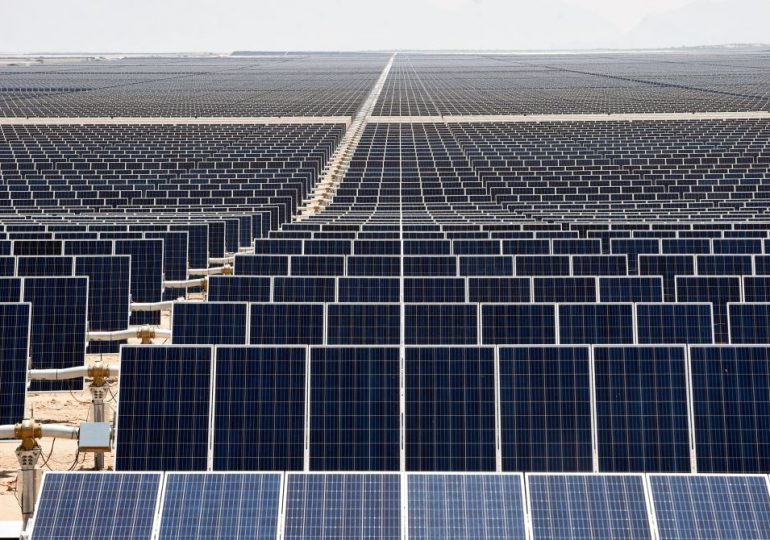Solar power continues to break record after record. If solar continues its current 5-year compound growth rate of 23%, then by the end of 2046, it could be supplying all our global energy demand at 2023 levels. By 2050, we could more than double our energy consumption globally and solar will still be generating more than we need.
[time-brightcove not-tgx=”true”]
This year, around 1 billion solar panels, and 70 billion of their constituent solar cells, will be manufactured around the world, mostly in China. It is the repetitive modular manufacturing process that has lent itself to the rapid efficiency improvements and cost reductions—90% in the last decade—underpinning solar’s near-exponential growth. In 2009, the International Energy Agency predicted total installed solar power capacity would hit 244 GW in 2030. That target was met 14 years early, in 2016, and the total today is 1,600 GW—over six times the 2030 forecast.
The modular nature of solar panels make for efficient manufacturing. But it is also ideal for small scale deployment, including on our homes. Globally, more than 25 million homes now have decentralized solar on their roofs. By 2030, this is likely to exceed 100 million, according to the IEA, though its forecasts have undersold solar before. So, could we up this forecast to 200 million, 500 million, or even 1 billion solar powered households by the end of decade?
Read More: Rooftop Solar Power Has a Dark Side
Here come the caveats. While the growth rate of deploying solar has been phenomenal, we must remember the first commercial solar farm was completed in California over 40 years ago, in 1982. In any near-exponential growth, the start of the graph always shows a long period of slow and insignificant deployment, before the growth rate bends the curve toward the vertical. In the case of solar, this period existed from the early 1980s to around 2005. It can be argued that solar didn’t reach truly disruptive deployment levels until 2015, when it first supplied more than 1% of global electricity, more than 30 years from the first solar farm in California.
You also can’t drive a solar cell to work, or fly on a magic carpet of solar panels. Other enabling technologies are needed to make solar energy useful. There are promising ones. These include electrolysers, heat pumps, and lithium-ion batteries. They can join the already-proven modular success stories of solar and wind.
The beauty of modular electrolysers is that they produce green hydrogen from electricity and water, meaning that we can utilize the electricity produced when there is too much wind or sun, and demand is low. This hydrogen from excess renewable electricity can then be used to generate electricity again when it’s cloudy and calm. It can also be stored seasonally, and utilized in industrial and agricultural processes, in future aircraft, and for powering cargo ships. Hydrogen elegantly compliments wind and solar, and electrolysers are continuing to fall in cost as more and more are produced.
As for modular heat pumps, they produce around three units of heat for every one unit of electricity input, and in 2021 a total of 190 million had been installed worldwide. Not only are they efficient, but importantly, they are also the only domestic heating source that runs on electricity.
You will now be familiar with the pattern, but let’s not leave out electric vehicles. There are around 7,000 lithium-ion battery cells in each Tesla. This highly modular technology is also rapidly falling in cost. Because electric vehicles can run on electricity from solar and wind, they are increasingly used to put power back on the grid when they are parked at home, acting as decentralized storage, known as bidirectional charging. Further, lithium-ion battery manufacturing for EVs has the spin-off effect of lowering stationary battery storage costs, again enabling the variability of solar and wind output to be smoothed.
Now for the realism. We don’t have limitless time to pursue carbon-free energy supply. Most net zero targets seek to achieve carbon neutrality over the next 25 years, or by 2050. More importantly, we are likely to pass 1.5C of warming, the Paris Agreement threshold target we are globally seeking to prevent breaching, by 2030. And it is at this 1.5C threshold that climatic feedbacks could kick in and lead to runaway climate change.
Nor do we have limitless money. Selecting the modular technologies that are synergetic and support each other is probably the best way to derive the most low-carbon energy, and decarbonize as quickly as we can, as cheaply as we can. But we don’t have 30 years to wait for these technologies to reach the truly disruptive deployment levels of solar only seen in recent years.
This is where we are going to also need to consider limiting demand, to meet the future constrained decarbonized supply. People will still be able to fly, and drive their non-EV car, but perhaps a little less often, until these technologies have had time to move along the growth curve. As climate change impacts increase in frequency and severity, this reality of carefully picking technology winners, backing them with more investment, and limiting demand, is highly likely to be the only option left.
Leave a comment








